Resume
|
要約
|
>Top 0. Introduction:
- This book complies various keywords for reorganizing knowledge. Here are quotation of some typical illustrations with some comments in English. English seems more suitable to express such key words.
|
0. 序章:
- 本書は知を再編する様々なキーワードを集めている。主な図を引用しつつコメントを付けて英語で表現した。キーワードを表現するには英語がより適切と思う。
|
>Top 1. Knowledge-Creating Community:
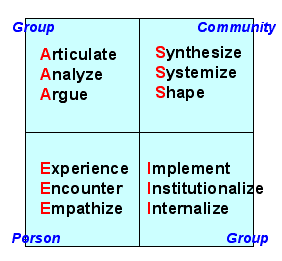 From thought to words, words to form, then form to know-how: From thought to words, words to form, then form to know-how: - SECI model is proposed by Ikujiro Nonaka.
|
1. 知識創造コミュニティ:
SECIモデル:by 野中郁次郎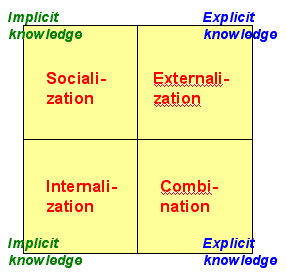 |
>Top 2. Memory Iceberg:
- Research of 'Awareness'
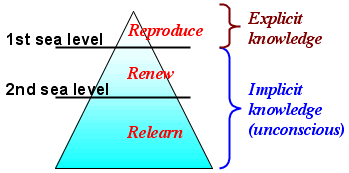
- Memory Iceberg:
- Reproducing, Renewing, Relearning level
- 'Renew' level memory is located between the first and the second sea level, which is renewed into explicit knowledge by being said, seen, or shown by someone.
|
2. 記憶の氷山:
- アウェアネス研究:
- 記憶の氷山
- 再生、再認、再学習のレベル
- 再認レベルは第1海面と第2海面の間の記憶で、他人によ9て言われる、見せられる、示されることによって形式知化する。
|
>Top 3. Linkage of Management & Technology:
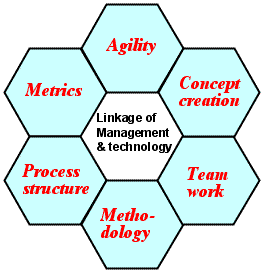 Model of MOT (Management of Technology): Model of MOT (Management of Technology):
- Creation of Concept (Abduction): create a new target.
- Process structure: find structural linkage.
- Metrics: develop by measuring.
- Methodology: make and utilize tools.
- Innovation by AID:
- Abduction
- Induction
- Deduction
- Knowledge increases much by abduction, a little by induction, but none by deduction.
|
3. 経営と技術のリンケージ:
- 技術経営のモデル
- コンセプトの創出:
ターゲットを生み出す
- プロセス構造:
つながり構造を見つける
- 計量:
測ることで進歩する
- 手法:
ツールを作り極める
- AIDによるイノベーション
- 帰納法
- 演繹法
- 演繹では知識は増えないが、帰納だと少し増え、アブダクションでは大きく増える。
|
>Top 4. Idea Creation Support System:
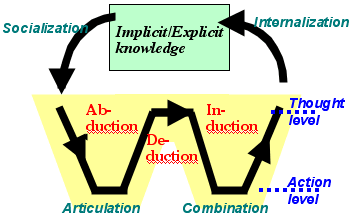 Jiro Kawakita's method solution method: Jiro Kawakita's method solution method:
- Kawakita's process of solution go seesaw between thought level and action level, showing W-shape method.
- Principle of brainstorming:
- No criticizing
- freewheelingness
- placing quantity before quality
- development by connection
- candor
- sudden realization
|
4. 発想支援システム:
- 川喜多二郎のW型問題解決学:
問題解決手順が思考レベルと行動レベルを上下し、W型となる。
- ブレーンストーミングの
- 批判厳禁
- 自由奔放
- 質より量
- 結合発展
- 虚心坦懐
- ふと気付くこと
|
>Top 5. Divergent thinking and convergent thinking:
-
Convergent
thinking |
Spacial |
Deduction |
bibliographic classification |
Induction |
KJ, 7x7, Cross method |
Serial |
Causal relation |
ISM, Dematel, Cause effect diagram |
Chronological order |
Story method, PERT |
- Deduction method: to save the way of thinking
- Induction method: to come up with novel ideas
- Casual relationship method: to find mater in question
- Chronological order method: to work out business schedule
|
5. 発散的思考と収束的思考:
- 演繹型:
思考を節約する場合
- 帰納型:
斬新な発想を求められる場合
- 因果型:
問題点を見つける場合
- 時系列型:
仕事のスケジュールを組む場合
|
>Top 6.
Knowledge Discovery:
- Deduction method:
hypothetical reasoning, analogical reasoning, logic of exchange of equivalence
- Human is mortal. (major premise)
- Socrates is a human. (minor premise)
- Therefore, Socrates is mortal. (consequence)
- Induction method:
hypothesis testing, generalization technology, data mining technology
- Socrates is a human.
- Socrates is mortal.
- Therefore, Human is mortal.
- Abduction method:
heredity algorithm,
intellectual catalyst technology, chaotic itinerancy
- Socrates is mortal.
- Human is mortal.
- Therefore, Socrates is a human.
|
6.
知識発見:
- 発想・演繹・帰納の例:
- 演繹法:
仮説推論、類推、等価変換の論理構造
- 人間は死を免れない (大前提)
- ソクラテスは人間である (小前提)
- 故に、ソクラテスは死を免れない (帰結)
- 帰納法:
仮説検定論、汎化技術、データマイニング技術
- ソクラテスは人間である
- ソクラテスは死を免れない
- ゆえに、人間は死を免れない
- 仮説発想法:
遺伝アルゴリズム、知的触媒技術、カオス的遍歴
- ソクラテスは死を免れない
- 人間は死を免れない
- ゆえに、ソクラテスは人間である
|
>Top 7. Knowledge Creation Buildings:
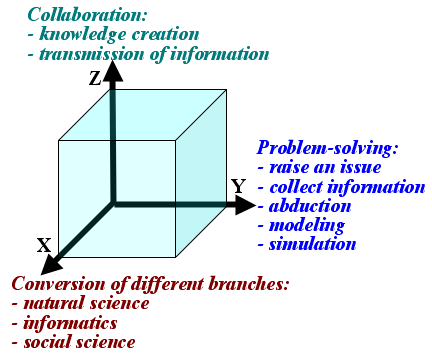 Grand design of knowledge creation buildings: Grand design of knowledge creation buildings:
- X-axis:
field of conversion of natural science, informatics, & social science
- Y-axis:
field of problem-solving:
to raise an issue, to collect information, abduction, modeling, & simulation
- Z-axisi:
filed of collaboration:
knowledge creation, ' transmission of information
|
7. 知識創造ビルディング:
- X軸:
文理融合の場
自然科学系、情報科学系、社会科学系)
- Y軸:
問題解決の場
問題提起、知識収集、仮説生成、モデリング、シミュレーション
- Z軸:
外部との連携交流:
知識創造、情報発信
|
>Top 8. Affordance:
- Definiton by Wikipedia:
An affordance is a quality of an object, or an environment that allows an individual to perform an action. James J. Gibson introduced the term in 1977. (The theory of Affrdances)
- Kepler's theory vs. Descartes theory
- Anti-Descartes way of thinking:
Is our base of recongnition endowed with reason beyond our senses, or endowed within our senses which do not necessitate our reason?
- Frame problem:
|
8. アフォーダンス: 可能ならしめる
- Wikipediaの定義:
個人が行動を起こすことを可能にする物体の性質や取り巻く環境のこと。
- ケプラー対デカルト
- 反デカルト的思考:
我々の認知基盤は感覚を超えた理性にあるのか、それとも理性を必要としない感覚の内にあるのか
- フレーム問題:
|
<The Frame Problem and the Fable of R2D2> by Daniel C. Dennett, American phylosopher
- Once upon a time there was a robot, named R1 by its creators. Its only task was to fend for itself. One day its designers arranged for it to learn that its spare battery, its precious energy supply, was locked in a room with a time bomb set to go off soon. R1 located the room, and the key to the door, and formulated a plan to rescue its battery.
- There was a wagon in the room, and the battery was on the wagon, and R1 hypothesized that a certain action which it called PULLOUT(WAGON, ROOM) would result in the battery being removed from the room. Straightaway it acted, and did succeed in getting the battery out of the room before the bomb went off. Unfortunately, however, the bomb was also on the wagon. R1 knew that the bomb was on the wagon in the room, but didn't realize that pulling the wagon would bring the bomb out along with the battery. Poor R1 had missed that obvious implication of its planned act.
- Back to the drawing board. "The solution is obvious," said the designers. "Our next robot must be made to recognize not just the intended implications of its acts, but also the implications about their side-effects, by deducing these implications from the descriptions it uses in formulating its plans." They called their next model, the robot-deducer, R1D1. They placed R1D1 in much the same predicament that R1 had succumbed to, and as it too hit upon the idea of PULLOUT(WAGON, ROOM) it began, as designed, to consider the implications of such a course of action. It had just finished deducing that pulling the wagon out of the room would not change the colour of the room's walls, and was embarking on a proof of the further implication that pulling the wagon out would cause its wheels to turn more revolutions than there were wheels on the wagon ... when the bomb exploded.
- Back to the drawing board. "We must teach it the difference between relevant implications and irrelevant implications," said the designers, "and teach it to ignore the irrelevant ones." So they developed a method of tagging implications as either relevant or irrelevant to the project at hand, and installed the method in their next model, the robot-relevant-deducer, R2D1 for short. When they subjected R2D1 to the test that had so unequivocally selected its ancestors for extinction, they were surprised to see it sitting, Hamlet-like, outside the room containing the ticking bomb, the native hue of its resolution sicklied over with the pale cast of thought, as Shakespeare (and more recently Fodor) has aptly put it. "Do something!" they yelled at it. "I am," it retorted. "I'm busily ignoring some thousands of implications I have determined to be irrelevant. Just as soon as I find an irrelevant implication, I put it on the list of those I must ignore, and ..." the bomb went off.
|
哲学者D. デネットによる<フレーム問題とR2D2ロボットの寓話>
- 昔、あるロボットR1号があり、バッテリーを長持ちするようにプログラムされていた。ある日、時限爆弾が仕掛られた部屋に入ったロボットは、バッテリーを救助するように指令された。
- その部屋には、台車があり、バッテリーはその上に乗っていた。R1ロボットは、その部屋から台車を持ち出せばよいと推論した。それを実施して、部屋から首尾良く台車を引き出すことができた。しかし爆弾も台車に乗っていたのである。R1は、爆弾が部屋の台車の上にあることは認識していたが、台車を引き出すことによって、バッテリーと一緒に爆弾も持ち出すことになるとは認識していなかった。バッテリーの上に爆弾が乗っていることに気づかず、部屋の外で時限爆弾は爆発したのである。R1の当初の計画には明らかなミスがあったのだ。
- そこで設計者は、この反省から次のロボットR1D1号を作成し、次のロボットには「予め決められた行動をする際には、当初の計画実施によって演繹される副次効果まで認識する機能を追加した。そして、R1D1号に部屋から台車を持ち出すように指示した。」
- R1D1号は、バッテリーの前までいって、推論を始めた。「バッテリーを動かしても、部屋の色は変わらない」とか「台車を引き出すことによってその車輪が台車の上にある車輪よりももっと多く回転させることになる」などと推論している内に、時限爆弾が爆発してしまった。
- そこでさらに設計者は、R2D1号機を制作し、「目的としている行為に関係することと、無関係なこととの区別を教えて、関係のないことは無視する機能」を追加した。しかし最新鋭のR2D1号はハムレットのように部屋の外で爆弾を抱えて考え込んでいた。R2D1号に「何をしているのか」と質問をすると「ちょっと待って!今、無関係のことを見つけ出して、それを無視するかどうか思案中です。無関係の事柄は何千とありますから」R2D1号が動き出す前に、またも時限爆弾は爆発した。
|
>Top 9. Next Genegration Innovation Model:
- First generation: Linear model
- Market needs are obvious.
- by researcher, invendor, or developer.
- Second generation: Chain-linked model (Klein model)
- Market needs are unobvious, which could be found by observation.
- by marketing, engineering
- Third generation: Hypothesis-revision model
- Market needs could not be found by observation only; which should be tested, ie, test-maketed quickly, then revist it by its respose.
- by abduction, prototype, market feedback
- Fourth generation:
Market creation model
- Develop a new product by collaborating of users and producer.
- by techno-producer, concept creator, coordinator, platform.
|
9. 次世代イノベーションモデル:
- 第1世代:リニアモデル
- 市場ニーズは自明
- リサーチャー、インベンダー、デベロッパー
- 第2世代:クラインモデル
- 市場ニーズは自明でない。観察すれば新規ニーズを発見できる。
- マーケティング、エンジニアリング
- 第3世代:仮説修正モデル
- 市場は観察するだけではニーズはつかめない。市場実験してニーズの把握をする。まずテストマーケティングして、その反応を見て修正
- アブダクション、プロトタイプ、マーケットフィードバック
- 第4世代:市場創造モデ
- 利用者と供給者の共同によって新商品を開発
- テクノプロデューサb、コンセプトクリエータ、コーディネータ、プラットフォーム
|

 From thought to words, words to form, then form to know-how:
From thought to words, words to form, then form to know-how: 

 Model of MOT (Management of Technology):
Model of MOT (Management of Technology):
 Jiro Kawakita's method solution method:
Jiro Kawakita's method solution method:
 Grand design of knowledge creation buildings:
Grand design of knowledge creation buildings: